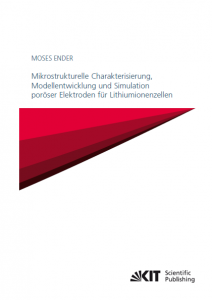A sequence of two paper was recently published in the Journal of The Electrochemical Society. The first part focuses on a simulative approach to evaluate different setups, the second parts takes an experimental approach to verify the findings and to demonstrate benefits, challenges and findings.
Both parts were published as open access articles. Details can be found in the publication section
Publication on Lithium Plating on Graphite Anodes
New publications available
There are two new publications in the Journal of Power Sources available. The first one is authored by my colleague Jörg Illig and deals with modelling the impedance of graphite anodes by means of serial and transmission line models.
The other one is authored by myself. Therein, an extended homogenized porous electrode model is introduced, exploiting the information about the particle size distribution from tomography studies. With this model, the coupling between small and large particles can be reflected, despite the homogenized nature of the model.
Detailed bibliographic information can be found at the publications page.
Anode microstructures from high-energy and high-power lithium-ion cylindrical cells obtained by X-ray nano-tomography
My most recent publication in the Journal of Power Sources is now available.Therein, the microstructures of two graphite negative electrodes (anodes) are characterized and compared. The three-dimensional microstructure reconstructions reveal important differences in the electrode designs.
Publication of my Dissertation
My Dissertation is finally published! The title is  Mikrostrukturelle Charakterisierung, Modellentwicklung und Simulation poröser Elektroden für Lithiumionenzellen and it is published at KIT Scientific Publishing.
Mikrostrukturelle Charakterisierung, Modellentwicklung und Simulation poröser Elektroden für Lithiumionenzellen and it is published at KIT Scientific Publishing.
It can be downloaded as pdf or bought as printed version at http://www.ksp.kit.edu/9783731502050.
Additionally, it can be found at the website of the KIT library: http://digbib.ubka.uni-karlsruhe.de/volltexte/1000040284
Analysis of functional layer and support structure of a SOFC anode
A new publication authored by my colleague Jochen Joos about the Quantification of Double-Layer Ni/YSZ Fuel Cell Anodes from Focused Ion Beam Tomography Data is now available. Bibliographic details can be found at the publications page.
Flight through a high power LiFePO4 cathode
The next video has been finalized and uploaded. It shows a flight around and through the pore space of a LiFePO4 cathode from a commercial high-power cell.
For more information, see flight through a high-power LiFePO4 cathode.
New video available online
I just uploaded an animation which shows a flight through the porosity of a glass fiber separator (the same way the lithium ions have to travel through the liquid electrolyte).
For more information, see flight through a glass fiber separator.
Novel method to measure the effective conductivity of a battery electrode
My most recent publication in Electrochemistry Communications is now available. Therein, a new method is introduced to measure the effective conductivity of an electrode for lithium-ion batteries. In addition to the conductivity, this method yields also the contact resistance between the electrode coating and the metallic current collector. The great advantage of this method, compared to others is, that it can be applied directly to the identical (disc-shaped) electrodes, that are usually used for electrochemical investigations.
3D impedance model publication now available
The work of a colleague of mine about spatially resolved FEM simulations of the impedance response of SOFC cathode structures has been published in the Journal of The Electrochemical Society. It is referenced at the publications page.
